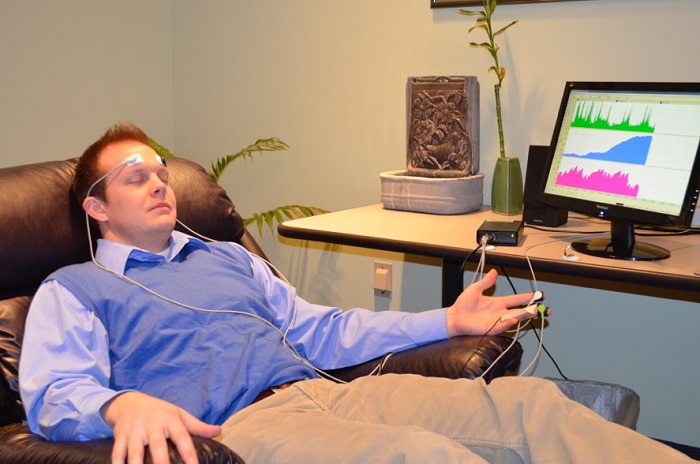The biofeedback of biofeedback therapy is a non-drug treatment in which patients learn to control bodily processes which are usually involuntary, such as muscle tension, blood pressure, or heart rate. It can help in a variety of conditions, such as chronic pain, urinary incontinence, high blood pressure, tension headache, and migraine headache; as it is non-invasive and does not involve drugs, there is a low risk of undesirable side effects, this could make it suitable for those who want to avoid medications or those who cannot use them, such as during pregnancy. It is often combined with relaxation training.
Index
What is biofeedback?
It is a mind-body technique that helps teach patients how to influence their autonomic nervous systems – the part of the body that controls involuntary physical functions, such as blood pressure, heart rate, muscle tension, and wave frequency. This is done by attaching an electronic “signal” to a measurable physiological process in the brain.
A person can thus monitor their internal responses and develop a sense of how to move them positively; biofeedback machines can detect internal bodily functions with sensitivity and precision and allow involuntary physical processes to be translated to be understood. The information, or feedback, that the signal provides is used to control these functions and facilitate the treatment of various disorders while moving the patient toward a more balanced internal state.
Biofeedback uses technology to provide you with information about critical systems in your body; this information allows you to control your body’s health better and teach your body to perform more optimally. It can be used to treat many conditions, such as chronic pain, headache tension, migraine tension, and high blood pressure; this therapy teaches relaxation techniques to calm the body, both mentally and physically, relieving unwanted symptoms.

Types of Biofeedback
There are many different types; the specific approach you choose may depend on what you hope to achieve and what your therapist or doctor recommends. Some of the available options include:
Breathing
Respiratory biofeedback involves using sensor bands around the chest and abdomen to monitor respiration rates and patterns. With training, people can learn to have greater control over their breathing levels which can help in various situations.
Heart rate
This type is known as heart rate variability biofeedback and is helpful as a treatment for several different disorders, such as asthma and depression. Patients using this type wear a device connected to sensors on the ears or fingers or sensors placed on the wrists, chest, or torso; these devices measure heart rate and heart rate variability.
Galvanic skin response
This type of biofeedback involves measuring the amount of sweat on the skin’s surface; the galvanic skin response, also known as skin conductance, is a valuable marker for detecting levels of emotional arousal. In addition to the apparent thermoregulatory function of sweat, emotional stimulation can also easily trigger sweating. The more excited people are, the stronger their skin conductance.
Blood pressure
This type of biofeedback involves using a device that measures blood pressure. These devices provide information about the patient’s blood pressure and often guide the patient through relaxation techniques that rely on visual cues, breathing exercises, or music. While these devices have gained popularity, a study reviewing eight previous trials found no convincing evidence that they have a long-term, lasting impact on hypertension.
Skin temperature
In this form of biofeedback, patients use sensors that detect the blood flow to the skin because they sometimes experience a drop in body temperature during times of stress; these devices can help better see when they begin to feel distressed. A low reading on one of these monitors may indicate the need to use some stress management techniques.
Brain waves
This type of biofeedback, also called neurofeedback, involves using electroencephalography to measure brain wave activity. Scalp sensors are connected to a device and are sometimes used as a non-invasive treatment for attention deficit disorder, pain, addiction, anxiety, depression, and other conditions.
Muscle tension
In this type, the sensors are placed at various points on the body and connected to an electromyography device; this device detects changes in muscle tension over time by monitoring the electrical activity that produces muscle contractions.
How does biofeedback therapy work?
The person in therapy will generally have a variety of sensors attached to different parts of the body; these sensors are installed by the therapist and send electrical signals to a monitor that is generally visible to the person being treated. The data received is returned to the individual in the form of flashing lights, images, or sounds, each corresponding to a specific physiological activity; the individual learns to adjust body reactions by changing thoughts, mood or behavior.
Learning how to control your body’s activity can promote better physical and mental health. For example, a person who experiences frequent headaches can learn how to identify the tight muscles that contribute to pain and relax them to reduce pain. Standard relaxation techniques taught during treatment include mindfulness meditation, deep breathing, guided imagery, and progressive muscle relaxation.
A typical biofeedback session can last 30 to 60 minutes; however, the duration of each session, the number of sessions required, and the type of biofeedback techniques used will depend on the problems experienced and how quickly the person in treatment learns to control involuntary physiological functions without the use of equipment.
How do you prepare?
You don’t need special preparation for biofeedback; to find a biofeedback therapist, ask your doctor or another knowledgeable healthcare professional to recommend someone who has experience treating your condition. Many biofeedback therapists are licensed in other areas of health care, such as nursing or physical therapy, and may work under the supervision of a physician.
State laws regulating practitioners vary; some therapists choose to become certified to show their additional training and experience in practice. Ask a potential biofeedback therapist before starting treatment, for example:
- Do you have a license, certificate, or registration?
- What are your training and experience?
- Do you have experience providing feedback on my condition?
- How many biofeedback sessions do you think I will need?
- What is the cost, and is it covered by health insurance?
- Can you provide a list of references?
How many sessions will you need?
Sessions usually last less than an hour. For some conditions, patients experience relief in 8 to 10 sessions. For other conditions, such as high blood pressure, it may take 20 sessions for improvements to appear.
Along with these sessions, mental and relaxation activities will be carried out that the individual will complete at home for 5 to 10 minutes per day.
Purpose of biofeedback
Biofeedback aims to combat stress through relaxation techniques, consciously manipulating your breathing, heart rate, and other generally “involuntary” functions to override your body’s response to stressful situations. It appears to be most effective for conditions heavily influenced by stress. Some examples include: learning disorders, eating disorders, bed-wetting, and muscle spasms.
There is growing research supporting biofeedback; the effectiveness of treatment varies depending on the condition being treated. Biofeedback can help alleviate:
- Post-traumatic stress disorder.
- Insomnia.
- Headache/migraine.
- Recurring abdominal pain.
- Fibromyalgia
- Chronic pain.
- Lower back pain/neck pain.
- Pain in the major and minor joints.
- Phantom limb pain.
- Non-cardiac chest pain.
- Digestive or elimination problems
- Irritable bowel syndrome.
- Urinary incontinence
- Fecal incontinence
- Diabetes.
- Epilepsy.
- Hyperhidrosis.
- Alcoholism / addiction.
- Facial muscle pain / Bell’s palsy.
- Congestive heart failure
- Muscle problems after stroke.
- Asthma.
- Incontinence.
- Constipation.
- Irritable bowel syndrome.
- Side effects of chemotherapy.
- High blood pressure
- Raynaud’s disease.
- Chronic pain.
- Stress or anxiety.
- Substance abuse.
Some people prefer biofeedback as a form of treatment for these conditions because it is non-invasive and does not depend on medications. Other people combine biofeedback with more traditional treatment options to improve general well-being.
Equipment used in biofeedback
Biofeedback therapy can use a wide variety of specialized equipment depending on the physiological functions being monitored; these sensor modalities include:
- Electromyography: Provides data on muscle tension.
- Feedback Thermometers: Provides information on skin temperature.
- Electrodermograms: Measure the electrical properties of the skin, which are often related to the activity of the sweat glands.
- Electroencephalograms: Measure brain waves and other brain electrical activities and are commonly used for neurofeedback.
- Pneumography: Measures chest expansion, chest contraction, and respiration rate.
- Photoplethysmography: Provides data on blood flow through a digit (for example, a finger), blood volume pulse, heart rate, and heart rate variability.
- Electrocardiograms: Provides information on the electrical activity of the heart and heart rate variability.
- Hemoencephalograms: Measure the relative amounts of oxygenated and deoxygenated blood in the brain area.
- Capnometers or capnography: Provides information on the quality of a person’s breathing by measuring the partial pressure of carbon dioxide gas in exhaled air.
- Air pressure devices: Commonly used to measure muscle performance.
Biofeedback treatment techniques
Along with visual and auditory feedback from biofeedback equipment and brain wave machines, people are encouraged to practice daily techniques to improve their skill levels.
The following are some of the more successful techniques:
- Progressive muscle relaxation.
- Deep muscle relaxation.
- Breathing and muscle awareness.
- Autogenic relaxation or rapid relaxation.
- Visual images.
- Open focus training.
- Systematic desensitization is a technique that helps develop an internal sense of control.
- Short forms of leisure (e.g., quieting response, exploration of body stress).
- Drag techniques to bring strategies to everyday life.
Biofeedback concerns and limitations
As biofeedback therapy tends to produce general feelings of well-being, treatment can provide symptomatic relief without addressing underlying medical concerns; people experiencing cognitive impairment may find it challenging to understand and execute the steps necessary for successful treatment.
The use of electrodes and other unfamiliar mechanical devices can make some people apprehensive, affecting readings; they can also arise due to ‘noise’ from surrounding electrical signals, extreme ambient temperatures, or poor contact between the electrodes and the skin. Since biofeedback equipment is used primarily in treatment settings, there may not be enough specialized equipment available to meet the needs of all people seeking treatment, and less expensive equipment may not give accurate readings.
Some critics claim that biofeedback is nothing more than an expensive form of muscle relaxation; therapy can be costly for people who require numerous treatment sessions. Many insurance policies do not cover biofeedback therapy.
Hello, how are you? My name is Georgia Tarrant, and I am a clinical psychologist. In everyday life, professional obligations seem to predominate over our personal life. It's as if work takes up more and more of the time we'd love to devote to our love life, our family, or even a moment of leisure.

